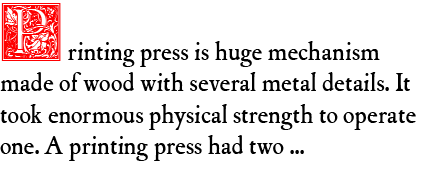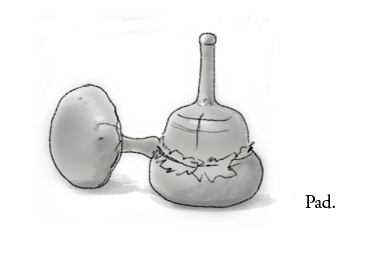S ELECT A F ONT



The printing process

T YPE SETTING AND I NKING
Typesetting used to be a very delicate process. Pieces of metal type were assembled into words and lines which were then transferred to a galley before being locked into a forme. Preparation of forme starts with precisely prepared type case. Type case is a compartmentalized wooden box used to store movable type. Capital letters were stored in a separate drawer or case that was located above the case that held the other letters. Capital letters were stored in alphabetical order, but lower drawer was organized as particular compositor seemed to be fit. The compositor has a sheet with a text before his eyes. He takes the pieces of type from the boxes (compartments) of the type case and places them in the composing stick - tool used to assemble pieces of metal type. The text was inked by separate craftsman. He used a pad mounted on handle. The pad was made of leather and inked. This ink was then applied to the text evenly. The pad had to be cleaned occasionally. The pad had to be hold in water for 8 hours to soften the leather. After, it had to be impregnated with flax oil. Pads had to be replaced very often, because quality of the print depends highly on them.

P APER P REPARATION
First printers used only natural inks. Those had a tendency to effuse if paper was not prepared correctly. Paper had to be damped. Damped paper was covered with scraps and hardly pressed. This process took about 8 hours.

P RINTING
A printing press is huge mechanism made of wood with several metal details. It took enormous physical strength to operate one. A printing press had two main parts: screw and bed or ‘coffin’. Screw was placed in a frame of the press. At the end it had a platen – metal plate pressed against paper. Screw was operated with a bar placed in the middle. A sliding table is called bed. Bed slides under platen. Prepared forme is placed into the bed. One forme contained two or several pages depending on size of the book. Afterwards types were fastened with yarns and covered with ink. Sheets of paper were laid down not onto the forme, but on a special device called tympan (two frames covered with paper or parchment). Tympan was fixed to the bed. Tympan had two needles in the middle that helped to hold the paper. This method of printing allowed to use only one colour at the time. Parts that had to be printed in different colour had to be left blank when first print was made and first colour had to be covered during second print. A frisket was used for this. Frisket is a wooden or metal frame covered with paper or carton with cut parts in those places where print had to be made. Tympan was placed on the forme, bed pushed under the platen and then the screw was turned pressing the paper to the forme and creating the print. After platen was lifted, the bed pulled out and frisket raised, the sheet of paper was taken from needles and hanged to dry. Printing part of the text in other colour meant that all process had to be repeated. Dried sheets had to be flattened by pressing them with a weight of approximately 20 kg.













